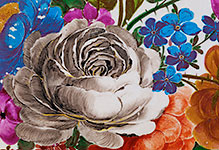
Flowers
Daisies, Lilies, Roses, Tulips and more.

#03060263
A night heron, 1635. From the Dara Shikoh Album. ID: Add Or 3129, fol. 9 verso

#03060268
Indian nasturtium; stem,leaves and red flowers; seeds in lower right. From "The...

#03060270
Spring and Summer flowers and grasses, Edo period, Japan, around 1840. Showing a...

#03060345
Bhairavi Ragini, Indian, around 1610. A woman worships a Shiva linga in a shrine...

#030702 9
Detail of a silk embroidery panel with flowers and ducks. Tang dynasty, 9th - 10...

#03070214
Coloured woodblock print from the Ten Bamboo Studio, Nanjing, China, around 1643...

#03070230
Detail of a silk embroidery panel with flowers and ducks. Tang dynasty, 9th - 10...

#03070234
'Fascination of Nature' from China, Yuan dynasty, 1321. The subject of this part...
![A basket of flowers, Ding family of the Jinchang pavillion, Suzhou, 1690. The inscription on this print identifies the Ding family as coming from [near] the Jinchang pavillion. The Jinchang pavillion was near the Chang gate, in north-western Suzhou. This is the area where the district of Taohuawu was located, which had many hundreds of print workshops in the early Qing dynasty. Each print is of an auspicious subject accompanied by a verse which is a pun on the motifs depicted.The basket is an attribute of Lan Caihe, one of the Eight Immortals. It represented a receptacle of riches and was a motif which was often used to evoke harmony. In this case, it comes with the wish that one's luck would be as fragrant and as plentiful as the flowers in the basket. The magnolia, wild apple and peony are all symbols of spring, and so this print would presumably have been used during the Chinese New Year. When the magnolia and wild apple are depicted together, it means, 'May your halls be rich and honoured'. The peony was also known as fugui hua, the flower of riches and honour.
OA, 1906.11-28.3](https://archive.lessingimages.com/photo/34330/thumb)
#03070238
A basket of flowers, Ding family of the Jinchang pavillion, Suzhou, 1690. The in...

#03070348
Emperor Shah Jahan. Moghul miniature, 1630. Gouache on paper, 22.2 x 13.4 cm.

#03070351
Krishna and Radha dancing in the rain with three girl musicians. India; Rajastha...

#03080554
View of Queen Anne's Grove, Bedford Park, London. Lithograph; 1882.



